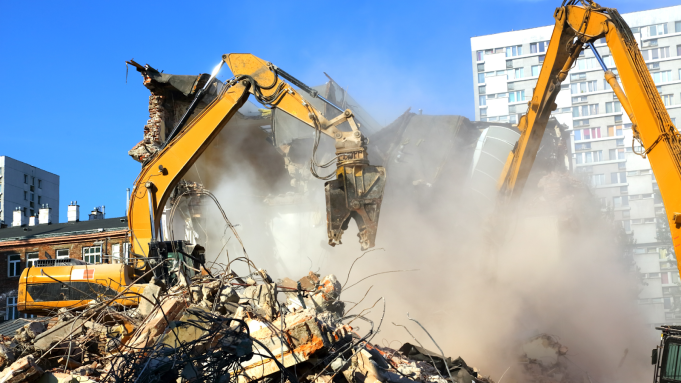USA Waste Statistics
In the US there are roughly 600 million short tons (or around 544 million tonnes) of C&D site ruble material being generated requiring disposal in 2018.
This is over double the solid waste being generated on site.
During 2018, 75% of all C&D waste was recovered and recycled.
Over 90% of C&D debris generation occurs through demolition, whereas construction is responsible for 10%.
Demolition represents more than 90% of total C&D debris generation, while construction represents less than 10%.
Roughly 413 million tonnes of C&D debris were channeled into reuse, and around 132 million tonnes had been sent to landfill.
United Kingdom Waste Statistics
During 2018, the UK had generated a total of 67.8 million tonnes of C&D refuse (not including excavation waste).
Out of the total, 62.6 million tonnes were channeled for recycling and reuse. Demonstrating a recovery rate of 92.3% A consistent recovery rate of 92% had continued from 2010 to 2018.
Demolition, construction and excavation (dredging included; CD&E) developed just over 3 fifths (62%) of all the waste being generated in the UK for 2018.
C&I refuse was responsible for roughly a fifth (19%) of the total waste being produced. Households and other activities were responsible for the remainder.
The majority of waste for processing ends up going through recycling and recovery (50.4%).
Around 60% of refuse being recovered from building sites is ruble and other solid stone materials. This includes materials used in laying roads as well as other structures. The majority of which are being generated through CD&E.
While avenues are mapped out to maximise the flow of material for reuse, some will inevitably end up at landfill. In 2018 it was recorded that 23.6% of CD&E waste found its way to landfill sites in the UK.
Waste Regulations
USA
In America the waste management strategy holds reuse, recycle and reduction in high importance. These practices are both relevant to household as well as C&D materials. More state as well as municipal regulations are being introduced which mandate the implementation of recycling C&D materials.
The Resource Conservation and Recovery Act (RCRA) refers to a refuse subset as hazardous waste. Several components occurring throughout the lifecycle of hazardous waste material on building sites must meet all of the requirements set out. An example would be any discarded paints and chemical components in addition to materials and items with any ignitability such as batteries.
UK
The industry has still shown to produce large amounts of waste in spite of a material shortage seen in 2021 (that has continued into 2022).
According to DEFRA, CD&E can account for 62% of waste in the UK recorded in 2018 – while shortages have altered that behaviour to a degree, more accommodations to process these materials need to be set in place.
New environmental legislation
With the Environmental Act 2021 (the new act) was given Assent last year. The targets set out will have a far reaching effect across sectors with the main aim being to improve biodiversity, air quality and waste reduction.
What about looking at our resource efficiency?
A tougher stance on reducing CD&E refuse
This act sets out to confer goals which will allow all sectors to attain anet waste amount to as close to 0 as possible:
- Extension of duty of care in regards to packaging waste with the aim of encouraging manufacturers to reduce the amount being used
- CHarges on single use plastic items
- Updating and enforcing new recycling methods
- Stricter regulation on the transportation of hazardous wastes
- Only export waste to OECD countries
- Refuse control and regulation.
The act has also set out to update all existing legislation on the matter (not limited to the environmental act of 1990. Alterations being focused on the removal, storage, separation and treatment of refuse materials in order to maximise the amount of material available for reuse.
How to reduce waste materials on construction sites
Set a designated space for the storage of waste material
A simple yet effective way to manage room on site is to establish a specific area where you may place larger skips and units for the storage of any waste that will allow you to hold larger amounts and control when and how you will prep the material for removal. Sometimes it may be better to use a compactor on site for prepping certain materials in order to make use of more space.
Wood waste, for example, makes up about 9 percent of the waste on an average construction site. Wood, however, doesn’t typically need to end up in a landfill. Instead, it can be re-used if appropriate, grounded and recycled/repurposed, or it can be donated to philanthropic building efforts.
Now once it has been prepared and stored more efficiently, you will now be able to separate them for collection meaning that you can have more control over your waste management strategy. Materials can be sent for recycling, treatment, repurposing or even to handlers who may purchase the material for resale.
Choose the right vendor
To ensure that you have a safe and secure waste management plan it is important that you ensure your vendors aren’t making use of unnecessary packaging on their materials. Excessive packaging will need to be stored, recycled and of course this still needs to be paid for which will increase the expenses on your site.
Consider the waste hierarchy
Spend your time carefully when planning your waste management strategy and ensure you have considered multiple possible scenarios for the various phases of your project. Ensure that any collectors or waste handlers have been vetted and checked for compliance to reduce the risk of encountering any unforeseen fines that may be incurred.
With these steps, we should see more significant shifts in how we are able to manage our refuse materials far more efficiently in a manner that will even reduce costs to both contractors and suppliers while not affecting product quality. These sweeping changes will be seen in the administration, logistics and education of those involved.














